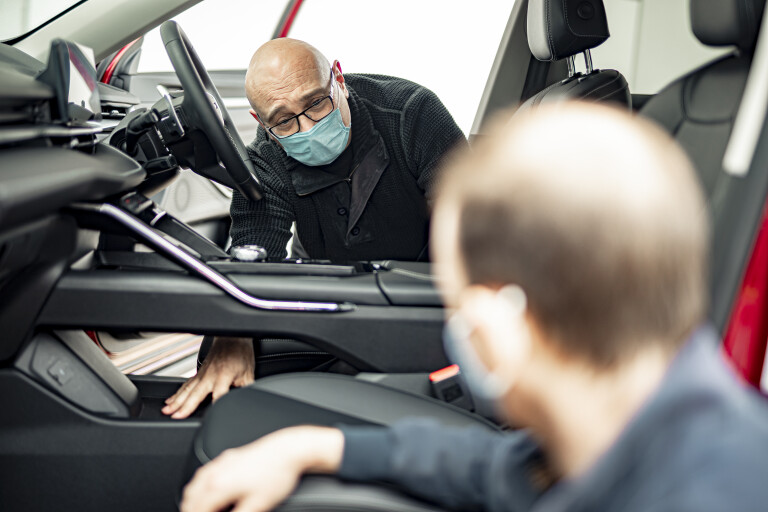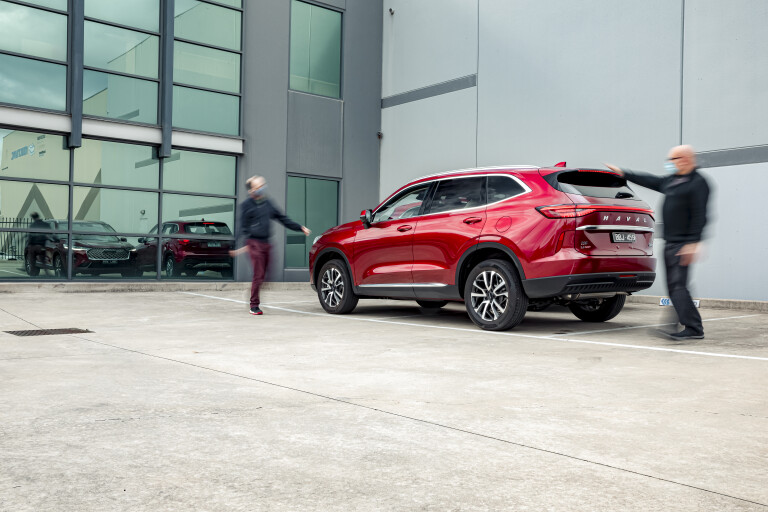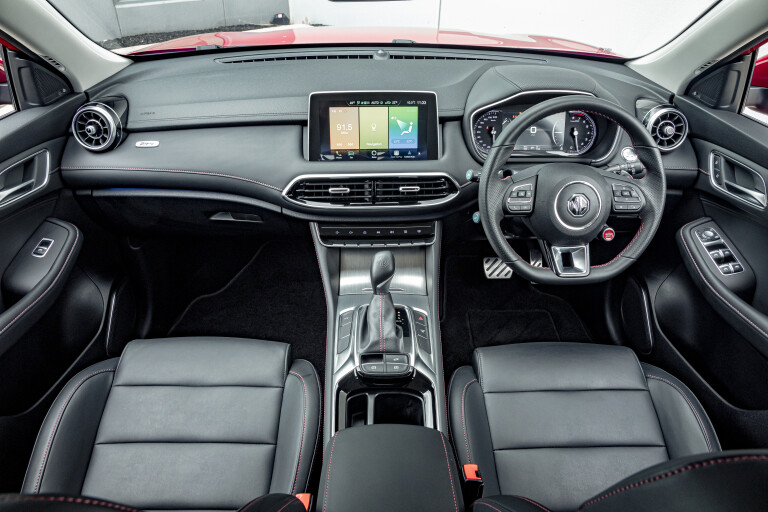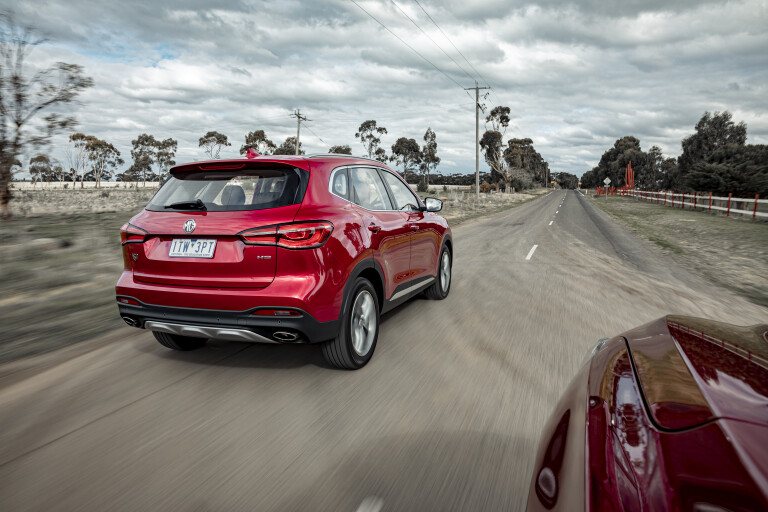
Rocketing skyward is the theme of 2021. Beardy Branson and Baldy Bezos took their billionaire backsides to the brink of outer space, whereas back on terra firma the popularity of the two cars you see before you, the MG HS and Haval H6, is growing exponentially with Australian buyers.
As of August 2021, sales of the MG are up 162 per cent year-on-year, whereas the Haval has found 280 per cent more buyers compared to this time in 2020. Neither is anywhere close to troubling the category favourites, the Mazda CX-5 and Toyota RAV4, but the MG is now snapping at the heels of the Honda CR-V and Kia Sportage while the Haval has passed the Ford Escape and Skoda Karoq on the sales charts and has its eyes on the Volkswagen Tiguan.
It’s clear plenty of punters are cross-shopping these two mid-size SUVs so it seemed only logical to put them head-to-head and see what’s what. Helping us in this assessment is design guru Richard Ferlazzo, formerly of the GM parish, who has happily agreed to offer his extensive experience and an OEM perspective to these vehicles. Of particular interest given the two cars’ attractive price tags is whether Richard can help identify whether corners have been cut in their build, presentation or development.

The Haval is the fresher of the two, the new-generation H6 having landed locally earlier in 2021 and, as our first drive has already confirmed, it’s a massive step forward over its underwhelming predecessor that finished a distant last in Wheels’ 2018 mega test. Our test car is the mid-spec 2WD Lux that costs $33,990 drive-away, nestled between the $30,990DA Premium and $36,990DA Ultra, the latter also available with all-wheel drive for an extra $2000.
The Lux is still well equipped, with 18-inch alloys, leather seats – the fronts heated and the driver’s eight-way electrically adjustable – a leather steering wheel with paddleshifters, keyless entry and start, a pair of 10.25-inch digital displays for the infotainment and instruments, a pair of USB ports front and rear, dual-zone climate control, six-speaker stereo, Apple CarPlay (though not Android Auto), rear privacy glass, LED lighting all ’round, front and rear parking sensors and a 360-degree camera.
In addition, there’s a comprehensive suite of active safety equipment, including AEB with pedestrian, cyclist and crossroad detection, forward and rear collision warning, lane departure warning and assist, exit warning, adaptive cruise control with traffic jam assist, blind-spot monitoring and traffic sign recognition, though rear cross-traffic alert and auto parking are limited to the top-spec Ultra.

Our MG HS is the $34,990DA HS Excite, which is again essentially the mid-spec variant, sitting between the $30,990DA Vibe and $38,990DA Essence. Unlike the Haval, all-wheel drive, as well as a more powerful 2.0-litre engine, is available on both the Excite and the top-spec Essence for $3000 and $4000 more respectively.
The MG is similarly stuffed to the gills, with 18s, a six-speaker stereo, 10.1-inch infotainment screen with smartphone mirroring (Apple and Android), dual-zone climate, leather seats, keyless entry and go, pair of USB ports front and rear, leather seats, leather steering wheel with paddleshifters, LED lights at both ends and all the same active safety kit as the Haval, though this time with rear cross-traffic alert as standard. It’s tit for tat in terms of spec levels, the MG lacking the Haval’s heated electric driver’s seat adjustment and 360-degree camera but countering with a powered tailgate and cooled centre console storage.
It’s clear plenty of punters are cross-shopping these two mid-size SUVs so it seemed only logical to put them head-to-head and see what’s what.

Where the two begin to diverge is inside. Richard offers his initial thoughts on the MG’s interior: “First impressions are it feels like it’s punching above its weight for opulence at this price. There’s a lot of real stitching, big Mercedes-style circular vents, nice steering wheel, soft on the console side to prevent banging your knee. Soft eject doors, brushed aluminium finish, electric park brake. I think the interior presents well, the screen’s nice and big, it’s certainly up level finishes.”
No arguments here. With its abundant leather surfaces, soft-touch plastics and contrasting red stitching, the MG could carry a much higher price tag, while the steering wheel could be a straight lift from the Mk VI Golf GTI, which is a compliment rather than a criticism really.
Richard feels the combination of analogue dials with the central digital screen isn’t quite as contemporary as the Haval’s widescreen offering but they are easy to read and the way the digital gauges complete the analogue circles is a neat touch. The centre screen is large and intuitive but its response to inputs is quite slow, which is frustrating, especially when adjusting the HVAC.
There’s ample space in the rear with a three-stage reclinable backrest and it’s well equipped with a pair of USB ports and air-con vents. There are large bottle holders in the doors and a leather-stitched fold-down centre armrest with a storage space for phones and a pair of fold-out cup holders. Further rearward, the electric tailgate opens to reveal a fully lined 463L boot, which increases to 1287L with the 60:40 rear seats folded down and includes a handy wet storage area beneath the floor along with a space-saver spare. Oddly, neither car has tie-down points in the boot.

Nevertheless, where the MG is spacious the Haval is cavernous. It looks a half-size bigger than the MG, closer to large than medium, and the dimensions bear this out with the H6 being 79mm longer, 10mm narrower and 39mm taller than the HS. This translates into a monstrous 600L boot, which expands to 1485L with the rear seats folded. There is no underfloor storage but the floor does have two heights to accommodate taller items and greater width above the wheelarches. Those arches are covered in hard plastic rather than soft felt like in the MG, though, and to get a power tailgate you need to stretch to the range-topping Ultra.
This abundant space carries over to the back seat, which is almost big enough to host stadium rock concerts. It should be able to accommodate three smaller humans across the back with relative ease, especially as the centre pew isn’t raised like in many rivals, making it much more useable. The backrest doesn’t recline like the MG, but the rear bench is soft and very comfortable, though Richard wished the contouring on the backrest continued on to the cushion for a little more visual flair. It matches the MG with a pair of vents and USB ports, but the door bins will only accommodate smaller drink bottles.

Switch to the front and you’ll find Haval has subscribed to a minimalist design ethos, eliminating virtually all buttons in favour of those two large screens. Over to Richard: “The Haval’s interior is bang on trend with two large colour display screens, a rotary gear selector and floating console with storage shelf. It’s minimalist but I rather like it. The floating centre console is lightweight visually with additional storage underneath. I’m not the biggest fan of rotary dials but I understand why they do it. There used to be a time when more buttons was better, but now everything is menu-driven it’s the size of the screen. Screens are now financially advantageous, too. There’s so little tooling involved, it’s easily updated and software can be flashed right up until the last minute.”
The centre infotainment screen can struggle to recognise inputs, often requiring a few taps, but if they are recognised they’re responded to in a more timely fashion than in the MG. More physical shortcut buttons would be handy in quickly accessing frequently used functions. The option of traditional dials on the digital instrument cluster would also be appreciated, but perhaps they are hidden in an undiscovered sub-menu. Both Richard – and Dan on his initial first drive – found the H6’s front seats flat and unsupportive but personally, they hold me better than the MG’s, which are nicely bolstered but quite wide, suggesting it may depend on body type.
Where the MG is spacious the Haval is cavernous. This abundant space carries over to the back seat, which is almost big enough to host stadium rock concerts.

Beauty is in the eye of the beholder, but it’s been Richard’s job for more than 30 years to ensnare that beholder, so what does he think of these two SUV upstarts?
“The exterior styling of both cars may not be trendsetting but they are certainly contemporary and well-executed. They also project very different personas. The H6 is crisp and chiselled with a solid proportion, albeit a bit rigid around the grille, and it could benefit from a more stylish badge. Generous chrome and hi-tech lamps give it an upmarket feel. The front doesn’t do it for me; there’s nothing wrong with square and angular but it’s just a little lumpy in places and a bit too glitzy around the grille. Again, nothing wrong with the pattern itself but chroming the whole grille is a little too chintzy.
“The MG looks and feels like a smaller and sportier vehicle. The exterior surface treatment is more curvaceous with a pronounced hip over the rear wheel. Like the H6, plentiful chrome and interesting lamp detailing add to the appeal. The HS is a little bit heavy over the front wheel; both cars have the black lower side strip as because SUVs are taller, there’s too much body mass so it’s a visual trick that makes it look more athletic and robust. The hard part is the proportions of an SUV really dictate its profile. To be different you need a different proportion and that usually comes with compromise – maybe less boot volume or rear headroom – otherwise everyone would be doing it.”

The divergent personalities are equally evident in the driving experiences. As its size and styling suggest, the MG is the sportier of the two. The ride is a little ‘springy’, the car falling into bumps then bouncing out of them, but is comfortable enough on most road surfaces. Well-weighted steering controls an obedient front end with the 235/50 Michelin Primacy tyres providing reasonable grip, though drive the HS in a fashion that any owner is unlikely to mirror and you’ll find mid-corner steering kickback over bumps, a soft brake pedal and eventual understeer, but even then a lift of the throttle will tuck the nose slightly.
Where the MG struggles is in the under-bonnet department. The little 1.5-litre turbocharged four-cylinder is no powerhouse with 119kW and 250Nm, but it’s the calibration that’s the real issue. That maximum torque is actually ample for decent progress but it’s delivered in odd lumps, the engine is noisy at high rpm and the seven-speed dual-clutch gearbox can struggle with decisiveness. Ticking the AWD box also adds a powerful 168kW/320Nm 2.0-litre turbo engine, though the six-speed dual-clutch it’s attached to is no smoother in operation.

The Haval has similar calibration issues in terms of smoothly delivering its power but the fact it has so much more of it, its 2.0-litre turbo four-cylinder producing 150kW and 320Nm, means you don’t have to extend it as frequently. This grunt does bring its own challenges, though, the H6 regularly wheel-spinning and torque-steering out of junctions if you’re slightly enthusiastic with the throttle, but the extra power is useful when it comes to overtaking (or, potentially, fully loaded for a driving holiday).
It’s not as dynamic as the MG – no great drama in this segment – but its softer suspension provides a more comfortable ride, albeit with some jitteriness on poor surfaces. There’s also more body movement than the MG but it actually has slightly better mid-corner balance, no steering kickback and an impressively subtle ESP calibration that gently adjusts the car’s attitude as necessary without aggressively cutting power or grabbing brakes. One negative is that the small back window severely limits rearward vision, particularly in the rear three-quarter.
The divergent personalities are equally evident in the driving experiences. As its size and styling suggest, the MG is the sportier of the two.

It’s easy to see why both these SUVs are flying up the sales charts. Both have enticing price tags, loaded equipment lists and lengthy seven-year warranties. More than that, though, both major on showroom appeal; on first acquaintance, whether that be stationary or on a short drive, it’s not immediately immediate why these vehicles cost less – like-for-like – than their immediate competitors.
Longer exposure reveals shortcomings in software response, powertrain calibration and dynamic polish, but the margins between these and the best are nothing like as big as they were only a generation ago.
Both MG and Haval have rightly prioritised space, safety, equipment and ownership peace of mind in the mid-size SUV segment and are being rewarded accordingly, but both would benefit from a local engineering effort in the manner of former challenger brands Kia and Hyundai.
But which is best? To a degree, the verdict is dependant on your buying priorities and taste, the Haval offering greater room and comfort along with a minimalist, almost austere, interior aesthetic. But our nod goes to the MG by a tiny margin for its cabin design flair and the fact its size and setup make it more agile when going slow and more fun when going fast.
SCORING
MG HS – 7/10
Haval H6 – 7/10
Specifications
| MG HS Excite | Haval H6 2WD Lux | |
| Body | 5-door, 5-seat SUV | |
| Drive | front-wheel | |
| Engine | 1490cc inline-4cyl, DOHC16v, turbo | 1988cc inline-4cyl, DOHC16v, turbo |
| Power | 119kW @ 5600rpm | 150kW @ 6000-6300rpm |
| Torque | 250Nm @ 4400rpm | 320Nm @ 1500-4000rpm |
| Fuel consumption | 7.3L/100km (combined/claimed) | 7.4L/100km (combined/claimed) |
| Weight | 1550kg | N/A (brand could not provide) |
| Power/weight | 77kW/tonne | N/A (brand could not provide) |
| Transmission | 7-speed dual-clutch | |
| Front suspension | struts, coil springs, anti-roll bar | |
| Rear suspension | multi-links, coil springs, anti-roll bar | |
| L/W/h | 4574/1876/1685mm | 4653/1886/1724mm |
| Wheelbase | 2720mm | 2738mm |
| Boot space | 463/1287L (rear seats up/down) | 600/1485L(rear seats up/down) |
| Steering | Electrically assisted rack-and-pinion | |
| Front brakes | 312mm ventilated discssingle-piston calipers | N/A (brand could not provide) |
| Rear brakes | 302mm solid discs | N/A (brand could not provide) |
| Wheels | 18 x 7.5-inch (f/r) | N/A (brand could not provide) |
| Tyres | 235/50 R18 (f/r) | 225/60 R18 (f/r) Hankook Ventus S1 Evo SUV |
| Price | $34,990DA | $33,990DA |
| Pros | Interior design and quality Equipment levels Value | Massive space Engine power Warranty |
| Cons | Lacklustre powertrain Slow infotainment | Traction issues Feels a bit cumbersome |

COMMENTS